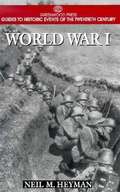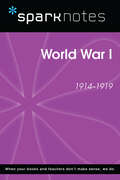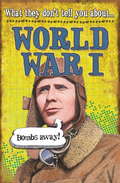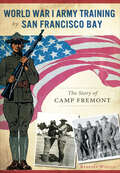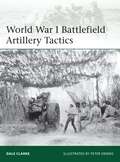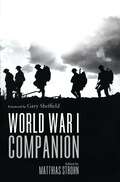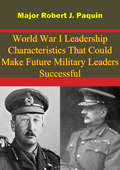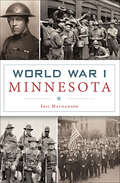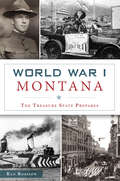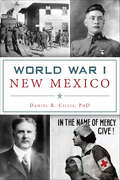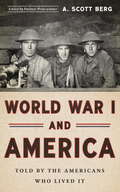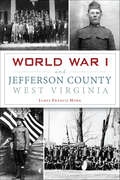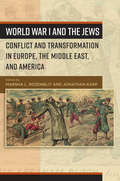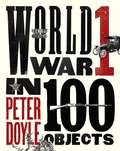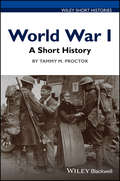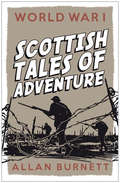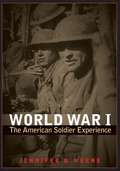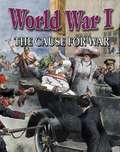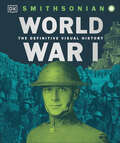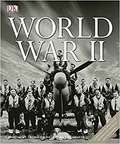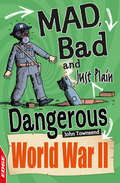- Table View
- List View
World War I
by Neil M. HeymanFrom the book's introduction: "This volume is intended to offer an introduction to the subject (World War I) to the general reader and students at the secondary school and college level. It seeks to be interesting as well as informative, and to present the results of recent historical study while giving an accurate view of the war's major features. I have placed my emphasis upon the war as conducted and experienced by the major countries of Europe as well as the United States. Events in Africa, the Middle East, and the Pacific attest to the fact that this was, indeed, a "world war," but the focal points of developments from 1914 to 1919 were on the continents of Europe and North America, as well as on or under adjacent bodies of water. With only a few exceptions, such as the Battle of Coronel and the Battle of the Falklands, those are the events we will explore."
World War I (Great Battles for Boys)
by Sibella Giorello Joe GiorelloYoung readers experience an unforgettable journey into World War I. They learn about the major battles, leaders, tactics, and strategies that helped the Allies topple the Axis powers. They'll also learn about new inventions, such as airplanes and tanks, which proved crucial to “The Great War." <p><p> Among the battles covered: <p> • Battle of Tannenberg: outnumbered German soldiers plan a sneak attack that destroys Russian forces, capturing 150,000 prisoners of war. <p>• Battle of the Somme: One of military history’s worst follies, this battle ended with more than one million casualties—and yet achieved almost nothing for either side. <p>• Battle of Cantigny: A little-known battle that proved the late-arriving American forces reached the Western Front ready to win. <p><p> Other chapters cover WWI’s most fascinating figures, such as Lawrence of Arabia, Sergeant York, the Harlem Hellfighters, and world events, including the Russian Revolution of 1917.
World War I (SparkNotes History Notes)
by SparkNotesWorld War I (SparkNotes History Note) Making the reading experience fun! SparkNotes History Guides help students strengthen their grasp of history by focusing on individual eras or episodes in U.S. or world history. Breaking history up into digestible lessons, the History Guides make it easier for students to see how events, figures, movements, and trends interrelate. SparkNotes History Guides are perfect for high school and college history classes, for students studying for History AP Test or SAT Subject Tests, and simply as general reference tools.Each note contains a general overview of historical context, a concise summary of events, lists of key people and terms, in-depth summary and analysis with timelines, study questions and suggested essay topics, and a 50-question review quiz.
World War I (What They Don't Tell You About #32)
by Robert FowkeThis book explains how the war started, what it was about and who it involved. It describes the major battles and looks at what life was like for the soldiers in the trenches, the pilots in the air, the sailors at sea and the civilians back home.Written in the lively style common to this series, the author deals with this difficult subject in a sensitive and skilful manner, introducing humour only where appropriate. With black line illustrations throughout.
World War I Army Training by San Francisco Bay: The Story of Camp Fremont (Military)
by Barbara WilcoxIn 1917, Stanford University leased a portion of its land to allow the creation of Camp Fremont, headquartered in present-day Menlo Park. That brought the war into the Bay Area's backyard. Soldiers received a welcome reception, and locals embraced the potential economic opportunities. However, the military presence also revealed the conflict Americans felt over the war. Residents threatened conscientious objectors within their community, while the government mollified fears of the vice that often followed troops in training. Armistice came earlier than expected, and many soldiers trained for combat they never saw. But all contributed to the growth and change that arrived with the modern era. Author Barbara Wilcox tells Camp Fremont's story of adaptability, bravery and extraordinary accomplishment during the Great War.
World War I Battlefield Artillery Tactics
by Dale ClarkeFrom the beginning of 'trench warfare' in winter 1914/15, artillery became the absolutely dominant arm in all the major armies for the rest of World War I, to a degree never seen before or since. The numbers and capabilities of the guns and ammunition available governed all the generals' battle plans; and the ways in which they were employed, and either succeeded or failed, decided the outcome of battles. The majority of the millions of casualties suffered during the war fell victim to artillery fire.The artillery war fell into three distinct phases along a four-year learning curve (with the necessary equipment and training for the second and third phases always lagging behind the tactical needs). The war began with mostly light, mobile artillery equipped and trained to support fast-moving infantry and cavalry by direct fire, mostly with air-bursting shrapnel shells.The entirely unexpected end of the first campaigns of manoeuvre as the armies bogged down in static trench warfare found both sides ill equipped and ill trained for what was in essence siege warfare on an industrial scale. This demanded more and heavier guns and high-explosive shells, and more complex skills for indirect fire - observation on the ground and in the air, locating targets (including enemy artillery), dropping the right kind of shells on them, the communications needed for co-ordinating the work of hugely increased numbers of guns, and getting many millions of shells up to them for week-long bombardments. These seldom worked as anticipated (classically, by failing to 'cut the wire' or to penetrate deep bunkers); so innovative officers on both sides worked to devise new tactics, with more versatile mixes of ammunition (e.g. gas shells, smoke shells, star shells and so on) and more imaginative ways of using them, such as box barrages and creeping barrages.Finally, in early 1918, the static slogging broke down into a renewed phase of manoeuvre warfare, made possible by sophisticated co-operation between artillery and infantry, plus the newly important air and mechanised forces. The lessons that were finally learned shaped the use of artillery worldwide for the rest of the 20th century.Fully illustrated with period photographs and specially drawn colour artwork and drawing upon the latest research, this engaging study explains the rapid development of artillery tactics and techniques during the conflict in which artillery played a pre-eminent role - World War I.
World War I Companion
by Mathias Strohn2014 sees the centenary of the start of World War I, the Great War - the war to end all wars. This four-year conflict saw the major powers of the world commit their forces on an unparalleled scale, principally in the trenches of the Western Front, but also throughout the world from the colonies of Africa to the Chinese city of Tsingtao.This was a period of intense development in military technology, technique, and innovation as the belligerent powers sought to break the deadlock. The rise of airpower, coronation of artillery, and development of the tank as a means of restoring mobility to the battlefield all came about in this period and have had a lasting influence through to the present day.This study consists of separate articles by 13 respected academics focussing on different aspects of the Great War, ranging from the war at sea, through the Gallipoli campaign to the final offensives of 1918 to give a wide-ranging companion to this truly global conflict.
World War I Leadership Characteristics That Could Make Future Military Leaders Successful
by Major Robert J. PaquinThis monograph analyzes the leadership characteristics that suggest a rapid acceptance of changing conditions in warfare among senior leaders and which leadership characteristics tend to suggest a more conservative approach. This conservative approach fails to recognize and adapt to the new emerging conditions. This research studied two World War I British leaders, General Sir Ivor Maxse and General Sir Hubert Gough, and compared and contrasted their leadership characteristics. From this, the research identified the most significant leadership characteristics that allowed these leaders to successfully adapt quickly in a time of transition.The criteria for analysis was based on four leadership characteristics as defined in FM 22-100, Army Leadership: Revised Final Draft, dated June 1998. The four leadership characteristics used as evaluation criteria were personal courage, initiative, tactical skill, and learning.A comparison of the role of the two World War I leaders yields the conclusion that certain leadership characteristics allowed them to adapt more easily in an evolving environment and facilitated successful battlefield leadership. These characteristics were moral courage, initiative, tactical skill and the application of knowledge through effective, continual learning.The monograph provides valuable insights into what leadership characteristics will allow current and future leaders to be successful, and unsuccessful, during a military transitional period. Our leaders must be creative, intuitive, dynamic, and able to make contemplated decisions, and have the courage and determination to act on them. The requirement for developing those leaders is an important one for the United States and a demanding one for the U.S. Army. An understanding of these leadership characteristics and the reasons that they facilitate successful battlefield leadership can provide an intellectual foundation beneficial to the Army as it prepares for future warfare.
World War I Minnesota (Military Ser.)
by Iric NathansonWhen the United States made a formal declaration of war on April 6, 1917, Minnesotans answered the call to arms. Duluth, with its strategic location at the head of the Great Lakes, emerged as a major shipbuilding center. Over forty thousand men registered for the draft in Minneapolis alone. Yet many members of the state's large German American population struggled with divided loyalties. A xenophobic fervor swept through the state at an alarming rate, forcing the government to establish a Commission on Public Safety to stifle wartime dissent. With more than fifty period photos and illustrations, author Iric Nathanson brings to life the daily struggles and triumphs of Minnesotans in the Great War.
World War I Montana: The Treasure State Prepares (Military)
by Ken RobisonMontana's cowboys, miners, foresters, farmers and nurses entered World War I in April 1917 under the battle cry that would resonate on the battlefields in France--"Powder River, Let 'Er Buck!" Montana men served in a greater percentage per capita than any other state. Hundreds responded to the call, including local women and minorities, from the nation's first congresswoman, Jeannette Rankin, to young women serving as combat nurses on the front lines. Additionally, the state provided vital supplies of copper and wheat. Learn what role celebrities like "cowboy artist" Charlie Russell played in the war and how Montanans mobilized, trained and deployed. Acclaimed historian Ken Robison uncovers new and neglected stories of the Treasure State's contributions to the Great War.
World War I New Mexico (Military)
by R. Cillis PhDIn 1917, five years after New Mexico received its statehood, the United States entered World War I. With border tensions festering between Mexico and the United States, Germany attempted unsuccessfully to secure Mexico's allegiance with its Zimmermann Telegram. More than sixteen thousand New Mexicans joined the military, while civilians supported from the home front. Groups like the Knights of Columbus, YMCA and the Salvation Army, as well as Governor W.E. Lindsey's New Mexico Council of Defense, raised military funding. Author Daniel R. Cillis recounts the Land of Enchantment's influence on World War I from its beginning through to the 1918 Armistice.
World War I and America: Told By the Americans Who Lived It (Library of America ##289)
by A. Scott BergFor the centenary of America's entry into World War I, A. Scott Berg presents a landmark anthology of American writing from the cataclysmic conflict that set the course of the 20th century. Few Americans appreciate the significance and intensity of America's experience of World War I, the global cataclysm that transformed the modern world. Published to mark the centenary of the U.S. entry into the conflict, World War I: Told by the Americans Who Lived It brings together a wide range of writings by American participants and observers to tell a vivid and dramatic firsthand story from the outbreak of war in 1914 through the Armistice, the Paris Peace Conference, and the League of Nations debate. The eighty-eight men and women collected in the volume--soldiers, airmen, nurses, diplomats, statesmen, political activists, journalists--provide unique insights into how Americans of every stripe perceived the war, why they supported or opposed intervention, how they experienced the nightmarish reality of industrial warfare, and how the conflict changed American life. Richard Harding Davis witnesses the burning of Louvain; Edith Wharton tours the front in the Argonne and Flanders; John Reed reports from Serbia and Bukovina; Charles Lauriat describes the sinking of the Lusitania; Leslie Davis records the Armenian genocide; Jane Addams and Emma Goldman protest against militarism; Victor Chapman and Edmond Genet fly with the Lafayette Escadrille; Floyd Gibbons, Hervey Allen, and Edward Lukens experience the ferocity of combat in Belleau Wood, Fismette, and the Meuse-Argonne; and Ellen La Motte and Mary Borden unflinchingly examine the "human wreckage" brought into military hospitals. W.E.B. Du Bois, James Weldon Johnson, Jessie Fauset, and Claude McKay protest the racist treatment of black soldiers and the violence directed at African Americans on the home front; Carrie Chapman Catt connects the war with the fight for women suffrage; Willa Cather explores the impact of the war on rural Nebraska; Henry May recounts a deadly influenza outbreak onboard a troop transport; Oliver Wendell Holmes weighs the limits of free speech in wartime; Woodrow Wilson envisions a world without war. A coda presents three iconic literary works by Ernest Hemingway, E. E. Cummings, and John Dos Passos.With an introduction and headnotes by A. Scott Berg, brief biographies of the writers, and endpaper maps.
World War I and Jefferson County, West Virginia (Military)
by James Francis HornFifty years after Jefferson County found itself wedged between the Union and the Confederacy, President Woodrow Wilson declared war on Germany and the Central Powers. Suddenly towns like Shepherdstown, Charles Town and Harpers Ferry once again prepared for war, this time an ocean away. Civilians supported the cause by donating to the Red Cross, and the county's large agricultural community produced food during rationing. More than five hundred Jefferson County natives enlisted, while more than three hundred additional soldiers came from college institutions within the county. Historian James Francis Horn recounts the struggles and triumphs of local communities during the Great War.
World War I and the Jews: Conflict and Transformation in Europe, the Middle East, and America
by Jonathan Karp Marsha L. RozenblitWorld War I utterly transformed the lives of Jews around the world: it allowed them to display their patriotism, to dispel antisemitic myths about Jewish cowardice, and to fight for Jewish rights. Yet Jews also suffered as refugees and deportees, at times catastrophically. And in the aftermath of the war, the replacement of the Habsburg Monarchy and the Russian and Ottoman Empires with a system of nation-states confronted Jews with a new set of challenges. This book provides a fascinating survey of the ways in which Jewish communities participated in and were changed by the Great War, focusing on the dramatic circumstances they faced in Europe, North America, and the Middle East during and after the conflict.
World War I and the Sacramento Valley (Military)
by Special theWhen the First World War thrust the United States into a dire global conflict, the Sacramento Valley was quick to mobilize. Many of America's first air units for combat were trained at Mather Field, while local farms filled some of the largest food supply orders for the Allies. Many women eschewed tradition and joined the industrial workforce at Liberty Iron Works, Southern Pacific Railroad and more. Though many banded together, the region's homefront was not without tension. Gripped by xenophobia, groups like the Liberty League formed local chapters to hunt spies, and local police forced displays of patriotism from suspected German sympathizers. With exclusive content from the Sacramento Public Library's Special Collections, librarians Amanda DeWilde and James Scott reveal the struggles and triumphs of the Sacramento region during the First World War.
World War I for Kids: A History with 21 Activities
by R. Kent RasmussenAn educational and interactive children's guide to the Great War In time for the 2014 centennial of the start of the Great War, this activity book provides an intriguing and comprehensive look at World War I, which involved all of the world's superpowers during a time of great technological and societal change. Emphasizing connections among events as well as the war's influence on later historical developments, it leads young readers to fully understand the most important aspects of the war, including how the war came about, how changing military technology caused the western front to bog down into a long stalemate, how the war fostered an era of rapid technological advances, and how the entry of the United States helped end the war. The book explores topics of particular interest to kids, such as turn-of-the-20th-century weaponry, air and naval warfare, and the important roles animals played in the war. Relevant crosscurricular activities expand on concepts introduced and illuminate the era of the early 1900s, including making a periscope, teaching a dog to carry messages, making a parachute, learning a popular World War I song, and more.
World War I in 100 Objects
by Peter DoyleA dynamic social history commemorating the 100th anniversary of the start of World War I General readers and history buffs alike have made bestsellers of books like A History of the World in 100 Objects. In that tradition, this handsome commemorative volume gives a unique perspective on one of the most pivotal and volatile events of modern history. In World War I in 100 Objects, military historian Peter Doyle shares a fascinating collection of items, from patriotic badges worn by British citizens to field equipment developed by the United States. Beautifully photographed, each item is accompanied by the unique story it tells about the war, its strategy, its innovations, and the people who fought it.
World War I: A Short History
by Tammy M. ProctorA lively, engaging history of The Great War written for a new generation of readers In recent years, scholarship on World War I has turned from a fairly narrow focus on military tactics, weaponry, and diplomacy to incorporate considerations of empire, globalism, and social and cultural history. This concise history of the first modern, global war helps to further broaden the focus typically provided in World War I surveys by challenging popular myths and stereotypes to provide a new, engaging account of The Great War. The conventional World War I narrative that has evolved over the past century is that of an inevitable but useless war, where men were needlessly slaughtered due to poor decisions by hidebound officers. This characterization developed out of a narrow focus on the Western Front promulgated mainly by British historians. In this book, Professor Proctor provides a broader, more multifaceted historical narrative including perspectives from other fronts and spheres of interest and a wider range of participants. She also draws on recent scholarship to consider the gendered aspect of war and the ways in which social class, religion, and cultural factors shaped experiences and memories of the war. Structured chronologically to help convey a sense of how the conflict evolved Each chapter considers a key interpretive question, encouraging readers to examine the extent to which the war was total, modern, and global Challenges outdated stereotypes created through a focus on the Western Front Considers the war in light of recent scholarship on empire, global history, gender, and culture Explores ways in which the war and the terms of peace shaped the course of the 20th century World War I: A Short History is sure to become required reading in undergraduate survey courses on WWI, as well as courses in military history, the 20th century world, or the era of the World Wars.
World War I: Scottish Tales Of Adventure
by Allan BurnettFrom the author of the And All That Series, a collection of stories of Scotland during World War I. Acclaimed children&’s author Allan Burnett turns his attention to the First World War in a book of explosively exciting and emotionally charged tales of bravery and adventure. Featuring the true exploits of soldiers, spies, pilots, sailors and many others, these stories, all based on interviews with these heroes themselves or their descendants, offer a unique, personal insight into the First World War that no conventional history book can ever hope to match.
World War I: The American Soldier Experience
by Jennifer D. KeeneWorld War I explores the daily lives of the men and women who served the United States in the Great War. Relying extensively on letters, diaries, and reminiscences of those Americans who fought or served in World War I, Jennifer D. Keene reports on the training camp experience at home; the journey overseas; and the unique difficulties African Americans, Native Americans, women, and immigrants encountered in the predominately white and native-born army. She also describes in vivid detail the perspective of naval and air service personnel and, for those on the ground in France, the horrors of static trench warfare and active engagement in combat. Chapters describe coping with and treating disease and wounds; the devastating frequency of death; and for those who came home, the difficult reentry into civilian life, as well as the causes, strategic decisions, and political outcome of the war. This volume includes a timeline, illustrations, and an extensive bibliography of recommended sources.
World War I: The Cause for War (World War I: Remembering the Great War)
by Natalie HydeMarking the 100th anniversary of World War I, this series takes a detailed look at the course of events in the Great War and the conflict's lasting impact on the world. Includes documents, artifacts and first-person accounts that will help young readers relate to the subject, as well as informative sidebars, short biographies, fact boxes, timelines and stimulating text-dependent questions that will keep readers engaged and motivated.
World War I: The Definitive Visual History, New Edition (DK Definitive Visual Histories)
by DKDiscover the misery of life in the trenches -- and how the Great War devastated Europe. Here is an original and exciting guide to the grim challenge of life or death on the Western Front. Devastating first-hand reports and contemporary photographs of the battles that slaughtered millions, together with a clear account of how nation upon nation sent their men to join the carnage, combine to present a dramatic "eyewitness" view of this most terrible war. See the bullet-riddled car of the heir to the throne of Austria-Hungary, everyday life in the dugout, sappers mining tunnels beneath the enemy, and Mata Hari learning the art of spying. Learn how people avoided gas attacks, when periscopes were used, what soldiers wrote home to their sweethearts and mothers, the best way to use a tank, how troops flattened a hillside, and the meaning of Armistice Day. Discover how it felt to go over the top, what happened to all the bodies, how people dealt with shell shock, why war led to revolution, and much, much more.
World War I: The Rest of the Story and How It Affects You Today, 1870 To 1935
by Richard J. Maybury Jane A. WilliamsAn examination of the ideas and events that led to World War I, events during the war, and how they led to World War II, written as a series of letters from a man to his niece or nephew.
World War II
by H. P. WillmottA dramatic new illustrated account of the most destructive war the world has ever seen
World War II (EDGE: Mad, Bad and Just Plain Dangerous #4)
by John TownsendTime to take a sideways look at the bizarre and outrageous from throughout history - and it's all TRUE!Which mad weapons were actually used during combat? Who was the bad guy in charge of the Nazi German air force? Which dangerous mission helped to capture the Nazis' new tank?Find out the answers to these questions inside, along with lots of facts, quizzes, and other bonkers stuff as you take a bumpy journey into the darkest crannies of World War II history with Mad, Bad and Just Plain Dangerous!
